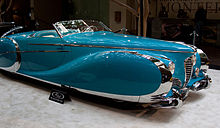Delahaye 175
Production build numbers were formally recorded from early 1948 to mid 1951, validating that 107 cars were built in the mechanically cloned three wheelbase series comprising the Types 175/175S, 178 and 180.
Managing Director Charles Weiffenbach had planned to debut the Type 175 at the October 1939 Paris Auto Salon.
The Paris Salon was where Delahaye received most of its purchase-orders, but the venue was cancelled without notice due to the impending German invasion.
The chassis featured Dubonnet independent front suspension built under license; an independent De Dion rear suspension system; large diameter, deeply finned drums on a dual Lockheed hydraulic brake system; a four-speed, semi-automatic Cotal transmission manufactured by MAAG; left-hand drive for the first time by Delahaye; and eighteen inch wheels.
The cockpit floor was welded to the bottom of the chassis to act as a stressed structural member, adding strength and torsional rigidity.
His absence resulted in extended delays, causing Delahaye to resort to trial-and-error experimentation while still building pre-war designs to generate revenue.
The incompletely assembled show chassis seen at the Paris Auto Salon to represent the optional Type 175S was not numbered.
Charles Weiffenbach, the managing director of operations, who ran the company single-handedly since his appointment in 1906, devised the intentionally confused reference number strategy.
The stressed-steel floor-pan was welded integrally around the bottom perimeter of the passenger compartment, providing exceptional rigidity.
In contrast, the all-new 4.5-liter chassis employed a sophisticated Dubonnet independent front suspension, licensed to Delahaye by its inventor.
The independent Dubonnet front suspension system was in use prior to the Delahaye, having been licensed to General Motors in 1933, as well as by Alfa-Romeo, Simca, and Vauxhall.
The excessive weight of traditional hardwood body-frames clad in mild steel, hand-hammered and welded steel-panelled coachwork, mounted atop these already heavy chassis, adversely affected acceleration and speed, while compromising handling.
Broken suspension components resulted in Delahaye being obliged to buy back the offending cars at considerable expense, to circumvent litigation, and negative publicity.
The Type 175S racing-engines Delahaye developed for Charles Pozzi, and racing-team Ecurie Lutetia co-owner and French champion driver Eugène Chaboud, reportedly had a 9.1:1 compression ratio, which with three dual-choke carburetors, delivered over 220 horsepower.
The more highly-tuned number 48771, after racing performance expert Fernand Lacour directed his efforts to develop a recorded 244.8 horsepower.
The plan designated Delahaye to build sports and luxury cars for the export market, to generate foreign currency.
[2] The show-chassis debuted in optionally equipped Type 175S form, with a partially built body by Letourneur et Marchand, introducing Delahaye's new postwar "face".
[3] The chassis was neither fully developed nor adequately tested by October 1946, before parts were put into production in late November 1947.
Delahaye was obliged to buy back an undisclosed number of defective cars, at great expense to the company, to defuse litigation and curtail negative publicity.
The mechanically and structurally unchanged show-chassis reappeared on Delahaye's stand in 1947, 1948, and 1949 for the final time, each year with minor additions made to freshen the partial forward coachwork.
The extended delivery delay, into early 1948, instead of 1946, was due to chief design-engineer Jean Francois' unanticipated death, in April 1944.
[1][5] While not a success in the marketplace, a Type 175S won the 1951 Monte Carlo Rally,[6] This car (815042) finished twelfth in the Carrera Panamericana, while a second Motto-bodied 175S coupe (815051) was disqualified on a technicality.
The independent front suspension had horizontally pivoting cylindrical housings that contained a coil-spring and hydraulic shock absorber immersed in an oil-bath Dubonnet.
[2] In desperation to salvage the company after the devastating 1953 fire, Managing Director Weiffenbach tried to amalgamate with various French automakers, to no avail.





